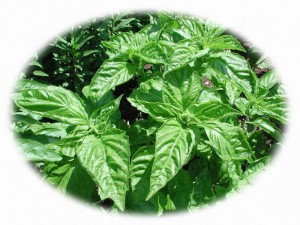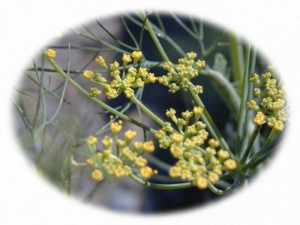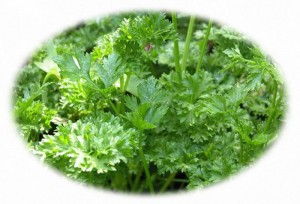Herbs and spices (Crop Group 19) consist of herbs, such as basil and mint, and spices such as coriander. Herbs are grown for fresh cut leaves or soft plant parts, usually harvested fresh but may be used fresh or may be dried and used later. Spices are ground, crushed, or processed parts of seed, bark or root parts of herbal plants. Field production. Field production in Texas involves ten to twenty full time herb growers with 10 to 20 acres of herbs. Additionally, some commercial vegetable growers also include herbs in their production program. Acreage estimates of this commercial production is summarized in Table 18. Production is primarily in the Lower Valley and Winter Garden area. Some herbal plants, such as aloe vera, dandelion, garlic, fresh parsley, and sesame are covered elsewhere in this publication. Herbs are typically hand harvested for fresh culinary use and marketed to upscale groceries and/or restaurants.
Container production. Container production of herbs includes small pots produced in greenhouses and wholesaled to garden centers. Some USDA statistics show 32 greenhouse herb growers in Texas with gross sales of $32 million. Part-timers and hobbyists. Small quantities are commonly produced and marketed for local sales. Numerous, perhaps 50 or more, other herbs and spices are grown in backyard gardens or landscapes throughout Texas. Several weedy species, such as lambsquarters, or relatives of horticultural crops, such as umbels (carrot family) are grown in herbal gardens.
Herbs
 Basil. Mint-like annual herb used for cooking, garnish, or medicinal purposes. Readily cross pollinates and several hybrids are available. Grown in plots of less than 0.1 acre for local sales. Some commercial harvests. Also a source of an organic insecticide and fungicide. Pests include Japanese beetle and annual weeds. Diseases of Botrytis, leaf and Sclerotinia blights, and Fusarium wilt.
Basil. Mint-like annual herb used for cooking, garnish, or medicinal purposes. Readily cross pollinates and several hybrids are available. Grown in plots of less than 0.1 acre for local sales. Some commercial harvests. Also a source of an organic insecticide and fungicide. Pests include Japanese beetle and annual weeds. Diseases of Botrytis, leaf and Sclerotinia blights, and Fusarium wilt.
Cilantro/Coriander. Cilantro is a leafy fern-like foliage that provides herbal garnish or flavoring for salads, soups, or other foods. Similar to parsley. A cool-season crop, grown from seed in the LRGV; planted in weekly intervals from October through March; emerges in about 2 weeks and ready for fresh harvest in 5 weeks or more with 2 to 3 cuttings/harvests as a green. Perhaps 15% is processed. Petiole and leaves are cut and tied in bunches for sale. Roots may be left on to keep the bundle fresher. Herbicides nearly essential at planting, no insects attack the crop, and diseases may include leaf spot, Alternaria, and powdery mildew. Coriander the dried seed portion of cilantro is used as a flavoring agent and spice; about 10 to 15 acres is commercially produced in Texas.
 Dill. Established from fall-planted seed and grows as a perennial. Seed and fruit are harvested for several years in commercial fields. Seed and leaves used for flavoring. Some used as a spice in pickling cucumbers. Produced by 10 to 20 commercial growers; about 82% for seed production. Some small plot production (less than 0.1 acre). Dill pests are similar to those in carrot.
Dill. Established from fall-planted seed and grows as a perennial. Seed and fruit are harvested for several years in commercial fields. Seed and leaves used for flavoring. Some used as a spice in pickling cucumbers. Produced by 10 to 20 commercial growers; about 82% for seed production. Some small plot production (less than 0.1 acre). Dill pests are similar to those in carrot.
Mint. Perennial, grown from vegetative material, multiple harvests from a field, and sold fresh. Major pests are loopers and cutworms; diseases are Verticillium wilt and rust. Produced by 15 to 25 commercial growers in Texas. Menthols and esters are distilled from peppermint and spearmint in the Pacific Northwest. 
Parsley – dried. If produced to be a dried herb, parsley is considered an herb. See “Parsley – fresh” in Leafy Vegetable group. Pests similar to radish and turnip
Rosemary. Hardy evergreen shrub, most common types with upright growth. Narrow green leaves harvested for fresh or dried flavorings for meats and fish, salads, baked goods, and tea. Produced as both a cut herb and potted plant; also used in landscapes. Some weed problems but no major insect or disease problems. Previously some commercial production on 300 acres in the High Plains near Seminole for use as an antioxidant for other products but crop lost due to untimely rains. Root rot in poorly drained soils.
Other herbs commercially grown in Texas include:
Chives. Similar to onions, grow in small clumps, commonly in pots.
Fennel. 15 acres for local use of leaves, seed heads, and stems. Little production for seed or oil.
Lavender. Past production in Hill Country, but limited by adaptation problems.
Oregano. Seeded, produces well, and frequently dried before use.
Sages. A common mint with numerous types but struggles in hot, humid summers.
Thymes. Contains antioxidants, aromatic; several types grown in Texas.
| Crop | Statewide Production | Acreage by Production Region | ||||||
|---|---|---|---|---|---|---|---|---|
| Acres | Dollar Value per Acre | Total Value (dollars in thousands) | Lower Valley | Winter Garden | Plains Region | Far West Texas | Eastern Areas | |
| Basil | 20 | $4,200 | $84 | 0 | 10 | 0 | 0 | 10 |
| Cilantaro | 430 | $4,200 | $1,806 | 400 | 10 | 0 | 0 | 20 |
| Dill | 220 | $3,000 | $660 | 200 | 0 | 0 | 0 | 20 |
| Mint | 220 | $3,400 | $748 | 100 | 100 | 0 | 0 | 20 |
| Parsley – dried | 15 | $2,800 | $42 | 0 | 10 | 0 | 0 | 5 |
| Rosemary | 100 | $2,800 | $280 | 0 | 10 | 80 | 0 | 10 |
| Other herbs | 40 | $2,800 | $112 | 10 | 10 | 0 | 0 | 20 |
| Totals | 1,045 | $3,571 | $3,732 | 710 | 150 | 80 | 0 | 105 |
